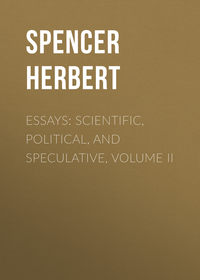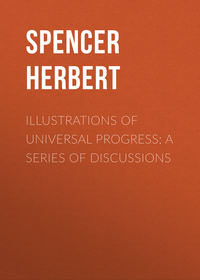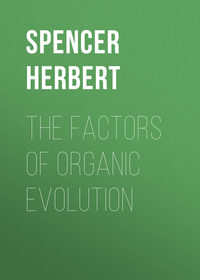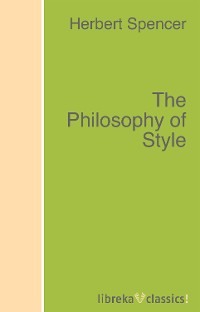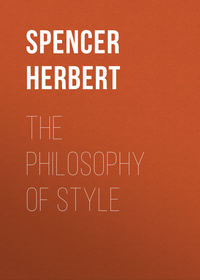 полная версия
полная версияThe Principles of Biology, Volume 1 (of 2)
An instructive parallelism may be noted between these processes carried on in the animal organism and those carried on in the vegetal organism. For the carbo-hydrates named, easily made to assume the soluble or the insoluble form by the addition or subtraction of a molecule of water, and thus fitted sometimes for distribution and sometimes for accumulation, are similarly dealt with in the two cases. As the animal-starch, glycogen, is now stored up in the liver or elsewhere and now changed into glucose to be transferred, perhaps for consumption and perhaps for re-deposit; so the vegetal starch, made to alternate between soluble and insoluble states, is now carried to growing parts where by metabolic change it becomes cellulose or other component of tissue and now carried to some place where, changed back into starch, it is laid aside for future use; as it is in the turgid inside leaves of a cabbage, the root of a turnip, or the swollen underground stem we know as a potato: the matter which in the animal is used up in generating movement and heat, being in the plant used up in generating structures. Nor is the parallelism even now exhausted; for, as by a plant starch is stored up in each seed for the subsequent use of the embryo, so in an embryo-animal glycogen is stored up in the developing muscles for subsequent use in the completion of their structures.
§ 23e. We come now to the supreme and all-pervading metabolism which has for its effects the conspicuous manifestations of life – the nervous and muscular activities. Here comes up afresh a question discussed in the edition of 1864 – a question to be reconsidered in the light of recent knowledge – the question what particular metabolic changes are they by which in muscle the energy existing under the form of molecular motion is transformed into the energy manifested as molar motion?
There are two views respecting the nature of this transformation. One is that the carbo-hydrate present in muscle must, by further metabolism, be raised into the form of a nitrogenous compound or compounds before it can be made to undergo that sudden decomposition which initiates muscular contraction. The other is the view set forth in § 15, and there reinforced by further illustrations which have occurred to me while preparing this revised edition – the view that the carbo-hydrate in muscle, everywhere in contact with unstable nitrogenous substance, is, by the shock of a small molecular change in this, made to undergo an extensive molecular change, resulting in the oxidation of its carbon and consequent liberation of much molecular motion. Both of these are at present only hypotheses, in support of which respectively the probabilities have to be weighed. Let us compare them and observe on which side the evidence preponderates.
We are obliged to conclude that in carnivorous animals the katabolic process is congruous with the first of these views, in so far that the evolution of energy must in some way result solely from the fall of complex nitrogenous compounds into those simpler matters which make their appearance as waste; for, practically, the carnivorous animal has no carbo-hydrates out of which otherwise to evolve force. To this admission, however, it should be added that possibly out of the exclusively nitrogenous food, glycogen or sugar has to be obtained by partial decomposition before muscular action can take place. But when we pass to animals having food consisting mainly of carbo-hydrates, several difficulties stand in the way of the hypothesis that, by further compounding, proteids must be formed from the carbo-hydrates before muscular energy can be evolved. In the first place the anabolic change through which, by the addition of nitrogen, &c., a proteid is formed from a carbo-hydrate, must absorb an energy equal to a moiety of that which is given out in the subsequent katabolic change. There can be no dynamic profit on such part of the transaction as effects the composition and subsequent decomposition of the proteid, but only on such part of the transaction as effects the decomposition of the carbo-hydrate. In the second place there arises the question – whence comes the nitrogen required for the compounding of the carbo-hydrates into proteids? There is none save that contained in the serum-albumen or other proteid which the blood brings; and there can be no gain in robbing this proteid of nitrogen for the purpose of forming another proteid. Hence the nitrogenizing of the surplus carbo-hydrates is not accounted for. One more difficulty remains. If the energy given out by a muscle results from the katabolic consumption of its proteids, then the quantity of nitrogenous waste matters formed should be proportionate to the quantity of work done. But experiments have proved that this is not the case. Long ago it was shown that the amount of urea excreted does not increase in anything like proportion to the amount of muscular energy expended; and recently this has been again shown.
On this statement a criticism has been made to the following effect: – Considering that muscle will contract when deprived of oxygen and blood and must therefore contain matter from which the energy is derived; and considering that since carbonic acid is given out the required carbon and oxygen must be derived from some component of muscle; it results that the energy must be obtained by decomposition of a nitrogenous body. To this reasoning it may be objected, in the first place, that the conditions specified are abnormal, and that it is dangerous to assume that what takes place under abnormal conditions takes place also under normal ones. In presence of blood and oxygen the process may possibly, or even probably, be unlike that which arises in their absence: the muscular substance may begin consuming itself when it has not the usual materials to consume. Then, in the second place, and chiefly, it may be replied that the difficulty raised in the foregoing argument is not escaped but merely obscured. If, as is alleged, the carbon and oxygen from which carbonic acid is produced, form, under the conditions stated, parts of a complex nitrogenous substance contained in muscle, then the abstraction of the carbon and oxygen must cause decomposition of this nitrogenous substance; and in that case the excretion of nitrogenous waste must be proportionate to the amount of work done, which it is not. This difficulty is evaded by supposing that the "stored complex explosive substance must be, in living muscle, of such nature" that after explosion it leaves a "nitrogenous residue available for re-combination with fresh portions of carbon and oxygen derived from the blood and thereby the re-constitution of the explosive substance." This implies that a molecule of the explosive substance consists of a complex nitrogenous molecule united with a molecule of carbo-hydrate, and that time after time it suddenly decomposes this carbo-hydrate molecule and thereupon takes up another such from the blood. That the carbon is abstracted from the carbo-hydrate molecule can scarcely be said, since the feebler affinities of the nitrogenous molecule can hardly be supposed to overcome the stronger affinities of the carbo-hydrate molecule. The carbo-hydrate molecule must therefore be incorporated bodily. What is the implication? The carbo-hydrate part of the compound is relatively stable, while the nitrogenous part is relatively unstable. Hence the hypothesis implies that, time after time, the unstable nitrogenous part overthrows the stable carbo-hydrate part, without being itself overthrown. This conclusion, to say the least of it, does not appear very probable.
The alternative hypothesis, indirectly supported as we saw by proofs that outside the body small amounts of change in nitrogenous compounds initiate large amounts of change in carbonaceous compounds, may in the first place be here supported by some further indirect evidences of kindred natures. A haystack prematurely put together supplies one. Enough water having been left in the hay to permit chemical action, the decomposing proteids forming the dead protoplasm in each cell, set up decomposition of the carbo-hydrates with accompanying oxidation of the carbon and genesis of heat; even to the extent of producing fire. Again, as shown above, this relation between these two classes of compounds is exemplified in the alimentary canal; where, alike in the saliva and in the pancreatic secretion, minute quantities of unstable nitrogenous bodies transform great quantities of stable carbo-hydrates. Thus we find indirect reinforcements of the belief that the katabolic change generating muscular energy is one in which a large decomposition of a carbo-hydrate is set up by a small decomposition of a proteid.12
§ 23f. A certain general trait of animal organization may fitly be named because its relevance, though still more indirect, is very significant. Under one of its aspects an animal is an apparatus for the multiplication of energies – a set of appliances by means of which a minute amount of motion initiates a larger amount of motion, and this again a still larger amount. There are structures which do this mechanically and others which do it chemically.
Associated with the peripheral ends of the nerves of touch are certain small bodies —corpuscula tactus– each of which, when disturbed by something in contact with the skin, presses on the adjacent fibre more strongly than soft tissue would do, and thus multiplies the force producing sensation. While serving the further purpose of touching at a distance, the vibrissæ or whiskers of a feline animal achieve a like end in a more effectual way. The external portion of each bristle acts as the long arm of a lever, and the internal portion as the short arm. The result is that a slight touch at the outer end of the bristle produces a considerable pressure of the inner end on the nerve-terminal: so intensifying the impression. In the hearing organs of various inferior types of animals, the otolites in contact with the auditory nerves, when they are struck by sound-waves, give to the nerves much stronger impressions than these would have were they simply immersed in loose tissue; and in the ears of developed creatures there exist more elaborate appliances for augmenting the effects of aerial vibrations. From this multiplication of molar actions let us pass to the multiplication of molecular actions. The retina is made up of minute rods and cones, so packed together side by side that they can be separately affected by the separate parts of the images of objects. As each of them is but 1⁄10,000th of an inch in diameter, the ethereal undulations falling upon it can produce an amount of change almost infinitesimal – an amount probably incapable of exciting a nerve-centre, or indeed of overcoming the molecular inertia of the nerve leading to it. But in close proximity are layers of granules into which the rods and cones send fibres, and beyond these, about 1⁄100th of an inch from the retinal layer, lie ganglion-cells, in each of which a minute disturbance may readily evolve a larger disturbance; so that by multiplication, single or perhaps double, there is produced a force sufficient to excite the fibre connected with the centre of vision. Such, at least, judging from the requirement and the structure, seems to me the probable interpretation of the visual process; though whether it is the accepted one I do not know.
But now, carrying with us the conception made clear by the first cases and suggested by the last, we shall appreciate the extent to which this general physiological method, as we may call it, is employed. The convulsive action caused by tickling shows it conspicuously. An extremely small amount of molecular change in the nerve-endings produces an immense amount of molecular change, and resulting molar motion, in the muscles. Especially is this seen in one whose spinal cord has been so injured that it no longer conveys sensations from the lower limbs to the brain; and in whom, nevertheless, tickling of the feet produces convulsive actions of the legs more violent even than result when sensation exists: clearly proving that since the minute molecular change produced by the tickling in the nerve-terminals cannot be equivalent in quantity to the amount implied by the muscular contraction, there must be a multiplication of it in those parts of the spinal cord whence issue the reflex stimuli to the muscles.
Returning now to the question of metabolism, we may see that the processes of multiplication above supposed to take place in muscle, are analogous in their general nature to various other physiological processes. Carrying somewhat further the simile used in § 15 and going back to the days when detonators, though used for small arms, were not used for artillery, we may compare the metabolic process in muscle to that which would take place if a pistol were fired against the touch-hole of a loaded cannon: the cap exploding the pistol and the pistol the cannon. For in the case of the muscle, the implication is that a nervous discharge works in certain unstable proteids through which the nerve-endings are distributed, a small amount of molecular change; that the shock of this causes a much larger amount of molecular change in the inter-diffused carbo-hydrate, with accompanying oxidation of its carbon; and that the heat liberated sets up a transformation, probably isomeric, in the contractile substance of the muscular fibre: an interpretation supported by cases in which small rises and falls of temperature cause alternating isomeric changes; as instance Mensel's salt.
Ending here this exposition, somewhat too speculative and running into details inappropriate to a work of this kind, it suffices to note the most general facts concerning metabolism. Regarded as a whole it includes, in the first place, those anabolic or building-up processes specially characterizing plants, during which the impacts of ethereal undulations are stored up in compound molecules of unstable kinds; and it includes, in the second place, those katabolic or tumbling-down changes specially characterizing animals, during which this accumulated molecular motion (contained in the food directly or indirectly supplied by plants), is in large measure changed into those molar motions constituting animal activities. There are multitudinous metabolic changes of minor kinds which are ancillary to these – many katabolic changes in plants and many anabolic changes in animals – but these are the essential ones.13
CHAPTER IV.14
PROXIMATE CONCEPTION OF LIFE
§ 24. To those who accept the general doctrine of Evolution, it need scarcely be pointed out that classifications are subjective conceptions, which have no absolute demarcations in Nature corresponding to them. They are appliances by which we limit and arrange the matters under investigation; and so facilitate our thinking. Consequently, when we attempt to define anything complex, or make a generalization of facts other than the most simple, we can scarcely ever avoid including more than we intended, or leaving out something which should be taken in. Thus it happens that on seeking a definite idea of Life, we have great difficulty in finding one that is neither more nor less than sufficient. Let us look at a few of the most tenable definitions that have been given. While recognizing the respects in which they are defective, we shall see what requirements a more satisfactory one must fulfil.
Schelling said that Life is the tendency to individuation. This formula, until studied, conveys little meaning. But we need only consider it as illustrated by the facts of development, or by the contrast between lower and higher forms of life, to recognize its significance; especially in respect of comprehensiveness. As before shown, however (First Principles, § 56), it is objectionable; partly on the ground that it refers not so much to the functional changes constituting Life, as to the structural changes of those aggregates of matter which manifest Life; and partly on the ground that it includes under the idea Life, much that we usually exclude from it: for instance – crystallization.
The definition of Richerand, – "Life is a collection of phenomena which succeed each other during a limited time in an organized body," – is liable to the fatal criticism, that it equally applies to the decay which goes on after death. For this, too, is "a collection of phenomena which succeed each other during a limited time in an organized body."
"Life," according to De Blainville, "is the two-fold internal movement of composition and decomposition, at once general and continuous." This conception is in some respects too narrow, and in other respects too wide. On the one hand, while it expresses what physiologists distinguish as vegetative life, it does not indicate those nervous and muscular functions which form the most conspicuous and distinctive classes of vital phenomena. On the other hand, it describes not only the integrating and disintegrating process going on in a living body, but it equally well describes those going on in a galvanic battery; which also exhibits a "two-fold internal movement of composition and decomposition, at once general and continuous."
Elsewhere, I have myself proposed to define Life as "the co-ordination of actions."15 This definition has some advantages. It includes all organic changes, alike of the viscera, the limbs, and the brain. It excludes the great mass of inorganic changes; which display little or no co-ordination. By making co-ordination the specific character of vitality, it involves the truths, that an arrest of co-ordination is death, and that imperfect co-ordination is disease. Moreover, it harmonizes with our ordinary ideas of life in its different grades; seeing that the organisms which we rank as low in their degrees of life, are those which display but little co-ordination of actions; and seeing that from these up to man, the recognized increase in degree of life corresponds with an increase in the extent and complexity of co-ordinations. But, like the others, this definition includes too much. It may be said of the Solar System, with its regularly-recurring movements and its self-balancing perturbations, that it, also, exhibits co-ordination of actions. And however plausibly it may be argued that, in the abstract, the motions of the planets and satellites are as properly comprehended in the idea of life as the changes going on in a motionless, unsensitive seed: yet, it must be admitted that they are foreign to that idea as commonly received, and as here to be formulated.
It remains to add the definition since suggested by Mr. G. H. Lewes – "Life is a series of definite and successive changes, both of structure and composition, which take place within an individual without destroying its identity." The last fact which this statement brings into view – the persistence of a living organism as a whole, in spite of the continuous removal and replacement of its parts – is important. But otherwise it may be argued that, since changes of structure and composition, though concomitants of muscular and nervous actions, are not the muscular and nervous actions themselves, the definite excludes the more visible movements with which our idea of life is most associated; and further that, in describing vital changes as a series, it scarcely includes the fact that many of them, as Nutrition, Circulation, Respiration, and Secretion, in their many subdivisions, go on simultaneously.
Thus, however well each of these definitions expresses the phenomena of life under some of its aspects, no one of them is more than approximately true. It may turn out that to find a formula which will bear every test is impossible. Meanwhile, it is possible to frame a more adequate formula than any of the foregoing. As we shall presently find, these all omit an essential peculiarity of vital changes in general – a peculiarity which, perhaps more than any other, distinguishes them from non-vital changes. Before specifying this peculiarity, however, it will be well to trace our way, step by step, to as complete an idea of Life as may be reached from our present stand-point; by doing which we shall both see the necessity for each limitation as it is made, and ultimately be led to feel the need for a further limitation.
And here, as the best mode of determining what are the traits which distinguish vitality from non-vitality, we shall do well to compare the two most unlike kinds of vitality, and see in what they agree. Manifestly, that which is essential to Life must be that which is common to Life of all orders. And manifestly, that which is common to all forms of Life, will most readily be seen on contrasting those forms of Life which have the least in common, or are the most unlike.16
§ 25. Choosing assimilation, then, for our example of bodily life, and reasoning for our example of that life known as intelligence; it is first to be observed, that they are both processes of change. Without change, food cannot be taken into the blood nor transformed into tissue; without change, there can be no getting from premisses to conclusion. And it is this conspicuous display of changes which forms the substratum of our idea of Life in general. Doubtless we see innumerable changes to which no notion of vitality attaches. Inorganic bodies are ever undergoing changes of temperature, changes of colour, changes of aggregation; and decaying organic bodies also. But it will be admitted that the great majority of the phenomena displayed by inanimate bodies, are statical and not dynamical; that the modifications of inanimate bodies are mostly slow and unobtrusive; that on the one hand, when we see sudden movements in inanimate bodies, we are apt to assume living agency, and on the other hand, when we see no movements in living bodies, we are apt to assume death. Manifestly then, be the requisite qualifications what they may, a true idea of Life must be an idea of some kind of change or changes.
On further comparing assimilation and reasoning, with a view of seeing in what respect the changes displayed in both differs from non-vital changes, we find that they differ in being not simple changes; in each case there are successive changes. The transformation of food into tissue involves mastication, deglutition, chymification, chylification, absorption, and those various actions gone through after the lacteal ducts have poured their contents into the blood. Carrying on an argument necessitates a long chain of states of consciousness; each implying a change of the preceding state. Inorganic changes, however, do not in any considerable degree exhibit this peculiarity. It is true that from meteorologic causes, inanimate objects are daily, sometimes hourly, undergoing modifications of temperature, of bulk, of hygrometric and electric condition. Not only, however, do these modifications lack that conspicuousness and that rapidity of succession which vital ones possess, but vital ones form an additional series. Living as well as not-living bodies are affected by atmospheric influences; and beyond the changes which these produce, living bodies exhibit other changes, more numerous and more marked. So that though organic change is not rigorously distinguished from inorganic change by presenting successive phases; yet vital change so greatly exceeds other change in this respect, that we may consider it as a distinctive character. Life, then, as thus roughly differentiated, may be regarded as change presenting successive phases; or otherwise, as a series of changes. And it should be observed, as a fact in harmony with this conception, that the higher the life the more conspicuous the variations. On comparing inferior with superior organisms, these last will be seen to display more rapid changes, or a more lengthened series of them, or both.
On contemplating afresh our two typical phenomena, we may see that vital change is further distinguished from non-vital change, by being made up of many simultaneous changes. Nutrition is not simply a series of actions, but includes many actions going on together. During mastication the stomach is busy with food already swallowed, on which it is pouring out solvent fluids and expending muscular efforts. While the stomach is still active, the intestines are performing their secretive, contractile, and absorbent functions; and at the same time that one meal is being digested, the nutriment obtained from a previous meal is undergoing transformation into tissue. So too is it, in a certain sense, with mental changes. Though the states of consciousness which make up an argument occur in series, yet, as each of them is complex, a number of simultaneous changes have taken place in establishing it. Here as before, however, it must be admitted that the distinction between animate and inanimate is not precise. No mass of dead matter can have its temperature altered, without at the same time undergoing an alteration in bulk, and sometimes also in hygrometric state. An inorganic body cannot be compressed, without being at the same time changed in form, atomic arrangement, temperature, and electric condition. And in a vast and mobile aggregate like the sea, the simultaneous as well as the successive changes outnumber those going on in an animal. Nevertheless, speaking generally, a living thing is distinguished from a dead thing by the multiplicity of the changes at any moment taking place in it. Moreover, by this peculiarity, as by the previous one, not only is the vital more or less clearly marked off from the non-vital; but creatures possessing high vitality are marked off from those possessing low vitality. It needs but to contrast the many organs cooperating in a mammal, with the few in a polype, to see that the actions which are progressing together in the body of the first, as much exceed in number the actions progressing together in the body of the last, as these do those in a stone. As at present conceived, then, Life consists of simultaneous and successive changes.


